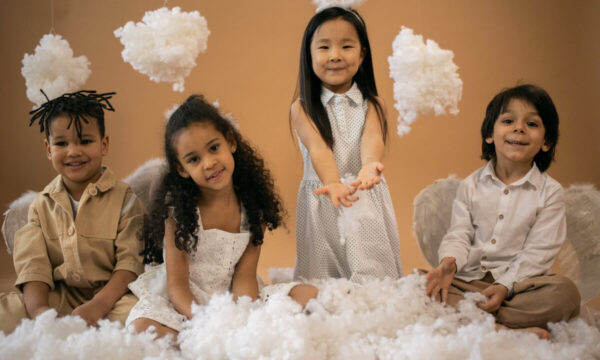It’s a routine practice within many Black households to discuss the state of race relations in the United States.
This shouldn’t be a shock to anyone when news cycles consistently pore over the increasing number of police shootings of unarmed Black people, instances of racial harassment in schools, the changes in school curriculums to make historical events like slavery more palatable and easier to digest for white students, and sociopolitical shifts that impact marginalized communities.
Black parents are forced to discuss these cruel and stifling circumstances with their children and contend with challenging realities that their kids will likely face at some point in their lives.

White American families, on the other hand, can easily bypass these conversations when the conditions are set for them not to have to encounter systemic oppression and racism. Regardless, they should talk to their kids. Discussions like these are more important than ever, especially when this country is entrenched in a dangerous, extremist political landscape.
When a white child attempts to drown a Black child in a pond while calling him racial slurs, when whole families are forced to skip town because their children are being bullied at school, and when race-conscious college admissions practices that are intended to bar the possibility of discrimination against Black people are declared unconstitutional, one cannot just sidestep conversations with their loved ones about the current state of the world, especially children who will one day inherit it.
So, what should these anti-racism talks consist of? How early is too early to start talking to your child about race relations in America?
White Parents: Get Comfortable with the Uncomfortable
In white households, parents don’t typically talk to children about race at all, according to the American Psychological Association. It makes sense, given that they don’t have to protect their children from racial discrimination.
Dr. Erin Pahlke, assistant professor at Whitman College, said that for white adults today who grew up in homes like this, it’s important to be intentional about self-education so that you know what to instruct your child in.
“Part of it is recognizing and acknowledging that it can be uncomfortable and difficult and part of it is being honest with your kid,” Pahlke told Atlanta Black Star. “Qualitative and quantitative research suggests that many white parents tell their kids, ‘We don’t talk about race’ or they shut down any conversation. If that’s the approach parents take, then kids aren’t getting messages from their parents about what kind of racial attitudes they want their kids to have.”
Although facing fraught and fractured race relations can be a challenge for families that don’t have to face its prejudicial effects, it’s still necessary.

Racial equity therapist Domenique Harrison tells us that the more parents lean into silence and anxiety, the more they invoke silence and anxiety in their children. White parents don’t need to know everything. They just need to engage with what they don’t know alongside their children and open themselves up to learning and bonding together to create a thoughtful and compassionate learning environment at home.
“Regardless of whether white parents were taught about race or not when they were children, they have to teach children how to live congruently and challenge injustice. Kids are making connections with their friends and asking questions about why their friends are different, and white parents can shy away and say we don’t talk about that because they’re uncomfortable,” Harrison said.
“If you hear something surprising, don’t dictate it as a negative thing. Lead from curiosity and flexible thought. The scariness for white parents is the fear of scaring their child and being unsure if they’re ready to receive those perspectives.”
Starting Age-Appropriate Discussions Early is Healthy
In truth, children are more ready to receive those perspectives than we think. It’s never too early to start talking to your child about race. In fact, the earlier, the better.
Research shows that as early as six months, kids can begin to distinguish and categorize skin colors in their brains, and from preschool ages, they start to notice race.
So start early and have those discussions regularly throughout a child’s development and in developmentally appropriate ways. Utilize age-appropriate tools and resources. Read children’s books with themes surrounding race, community, and equity. Find suitable YouTube videos.
Fill your home with toys and action figures that model appropriate skin and body norms that reflect your children and others. Model interactions with people of as many races, identities of dominance and non-dominance as possible. Just as you take your children to aquariums and zoos for fun, go to museums and visit different cultural spaces.
“Make sure there are characters in the books in your house that don’t just include white folks and go into spaces and go to events with folks who are celebrating different cultural events and how to value diversity in our world,” Pahlke said.
“As kids move into elementary school, read about some of the history of race relations in the U.S. As they transition to early adolescence, they have the cognitive skills to understand structural factors,” Pahlke added. “The research suggests it’s better to have those conversations with kids and open up those dialogues than stay silent; otherwise, kids are going to struggle to determine and explain the variations and experiences they see in the world. If you just hope they’ll get it in school or some teacher will talk to them about it, that won’t be sufficient.”
It’s also important to be mindful of what should be at the center of these discussions and what you want your child to get out of it. These discussions gift them with significant perspective and flexibility of thought.
“Parents can’t limit what their children see in school, but they can talk about what happens when they have a response to it,” Harrison said. “The more white parents continue to silence themselves for fear of how their kids will receive hard perspectives, the more we’re teaching silence and complacency to white children.”

Don’t Be Afraid to Discuss Very Real and Difficult Racial Concepts
White privilege. Colorism. Colorblindness.
These concepts play out constantly in everyday society and have detrimental and disproportionate impacts on communities of color.
Exposure to these very real social and systemic truths can trigger negative feelings, and it’s easy to want to retreat from those emotions or recoil from the existence of these social norms because someone “feels bad.”
However, experts point out that we have to move past this notion that white guilt and fragility is enough reason to invalidate or withdraw from the very present and universal reality of privilege. Feelings aren’t facts. It’s imperative to teach children how to cope with their emotions so that they know how to respond appropriately and maturely to the facts. According to experts, if people can’t cast aside their feelings, they will constantly look through this lens of what makes them feel good rather than what is good.
It’s unlikely that very young children will understand these concepts, so the times for these conversations are when your children are older and have the mental capacity to fully weigh them, Pahlke recommends.
“Theoretical models suggest that around age 12 or 13, kids have the cognitive skills and if they’re able to recognize examples of individual and structural racism, then they can understand the concept of white privilege,” said Pahlke. “White parents should talk about white privilege explicitly and frame that discussion of white privilege in terms of what you’re going to do, positive actions, and what positive action is and what it is not.”
It’s also very possible to teach kids how to use white privilege to elevate other communities, not out of savior or guilt complexes, but in healthy ways that empower the underrepresented, Harrison told ABS. That means elevating Black voices rather than your own, learning how to create a full and rich communal experience for kids of all backgrounds, constantly listening and self-reflecting, and being brave enough to check and educate people of your background when they’re uninformed or misinformed.
“We can teach kids to stand up in a way that feels really good and proud and empowering. It starts with acknowledging that race-oriented privilege is also tied with other identities that we prioritize over others. White privilege is really about the privilege white communities have because they have been given access to more resources: financial, communal, systemic, and school-based. It’s really about naming that it’s more than you sitting in a white body,” Harrison said.
“For kids who are in high school, parents should talk to them about their jobs or if they have family businesses handed down through generations that serve as an example of generational wealth that people in other communities don’t have.”
Another difficult topic to broach can be colorism and how non-Black people tend to perceive Black people with lighter skin tones as less threatening. Harrison underscored the necessity for more nuanced conversations about all shades of color because of negative narratives and perceptions that are placed on kids of darker skin tones. It’s important to discuss how to properly perceive what is “different” and moralize difference.
“We need to talk about how difference invites curiosity and inquiry and inquiry is wonderful,” Harrison said. “Being curious and questioning of things is great for our brains, so we have to invite from a very early age flexibility of thought and mindset for our kids so as early and as often as we can, have age-appropriate conversations and model as adults our own flexibility.”
These conversations can also directly offset “colorblindness,” an approach that stems directly from a desire not to face racism.
“White parents tend to believe that their children automatically won’t notice race and will grow up with egalitarian racial attitudes,” Pahlke explained. She added that one of the problems with a colorblind ideology is that it causes fundamental issues with “interracial interactions, a parent’s ability to function in a multiracial society, and negative outcomes for nonwhite folks and their communities.”
Books, Media, and More Resources on Race
Below are some resources for parents looking for kid- and adult-friendly sources on race recommended by Harrison and the Atlanta Black Star team.
- “Crash Course: Black American History” by Clint Smith (YouTube series for children and parents)
- “13th” directed by Ava Duvernay (Netflix documentary)
- “A is for Activist” by Innosanto Nagara (children’s book)
- “Change Sings” by Amanda Gorman (children’s book)
- “Shady Baby” by Gabrielle Union (children’s book)
- “Sulwe” by Lupita N’yongo (children’s book)
- “Why Are All the Black Kids Sitting Together in the Cafeteria?” by Beverly Tatum (adult novel)
- “So You Want to Talk About Race” by Ijeoma Oluo (adult novel)
- “How to be an Antiracist” by Ibram X. Kendi (adult novel)
- “The New Jim Crow: Mass Incarceration in The Age of Colorblindness” by Michelle Alexander (adult novel)
- “Just Mercy” by Bryan Stephenson (adult novel)
- Early Risers Podcast hosted by Dianne Haulcy (parents’ podcast resource)


